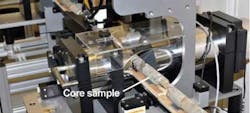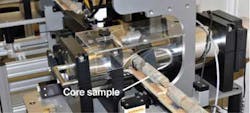P.2 ~ Foamed cement may help ensure wellbore integrity in deepwater
View Article as Single page
Analytical tools
The NETL laboratory houses a tri-axial multi-sensor core logger custom built to measure key geophysical properties like resistivity, gamma-density, and p-wave velocity. As a complement to NETL's CT scanning capabilities, the logger can provide high-resolution 2D graphs scanned down the length of a lab- or field-generated sample, providing data on a greater range of properties.
NETL also can analyze and characterize a variety of wellbore materials using petrography, environmental scanning electron microscopy with energy dispersive spectroscopy, x-ray and micro-x-ray diffraction, permeametry, thermogravimetric analysis, differential scanning calorimetry, and infrared and Raman spectroscopy. Analyses are used to characterize the fundamental properties of ultra-deepwater and frontier region reservoirs, unconventional natural gas and oil reservoirs, and reservoirs that offer potential for CO2 storage. Information gained helps NETL and its partners better understand field test sites, and it feeds computational models and simulations, risk assessments, and experimental studies investigations.
Research results
NETL researchers have produced the first high-resolution CT 3D images of two sets of atmospheric-generated foamed cement recipes across a range of foam qualities. CT imaging enabled the assessment and quantification of the foamed cement structure, quality, and bubble size distribution in order to provide a better understanding of foamed cement. Results are reported in NETL-TRS (Technical Report Series) -2-2013 "Computed Tomography and Statistical Analysis of Bubble Size Distributions in Atmospheric-Generated Foamed Cement," Kutchko et al., 2013; and NETL-TRS-2-2014 "Addendum 1 to Computed Tomography and Statistical Analysis of Bubble Size Distributions in Atmospheric-Generated Foamed Cement," Kutchko et al., 2014.
The testing of the physical properties of those same two foamed cement recipes (atmospheric-generated) has been completed. The physical properties include permeability, porosity, compressive strength, Young's modulus, and Poisson's ratio. The results indicate a clear correlation between the physical properties and the gas distribution of both sets of cements.
In addition, an upper/lower limit to foam quality that is guided by the mechanical/physical properties can be observed. For example, the foam quality (gas content) should not be too low because it will lack the mechanical benefits as shown by Young's modulus values. The foam quality also should not be too high as it still needs to provide zonal isolation. The results of this research are written in a TRS, which is undergoing review.
Currently, three major service companies have supplied NETL with field-generated foamed cement samples. These samples were collected using the same full-scale industrial equipment and methodology used to generate cement in a well. Using the methodology developed for the atmospheric-foamed cements, NETL researchers have produced the first X-ray CT, 3D images of field-generated foamed cement across a range of foam qualities and pressures.
CT scans and image analysis of atmospheric-generated foam cements (Kutchko et al., 2013) revealed bubble distributions that were larger (increasing with increased foam quality), more uniform in size, and more evenly distributed than that seen in field-generated foamed cements. The observed patterns indicate a high level of complexity of in situ foam cement behavior. The variations in cement structure within the pressurized foamed cement samples all appear to indicate a strong relationship between the flow of the cement slurry and the final porosity and properties of the in-place hardened cement. Work is continuing to isolate flow, distribution, and other relevant properties that can be engineered into safer and more efficient placement of foamed cement downhole.
Given the success of the atmospheric-generated foamed cement work, the next step is to apply this methodology to field-generated and pressure-generated foamed cements. A correlation between atmospheric-, field-, and pressure-generated foamed cement systems is important to improve understanding of the physical properties of foamed cement under wellbore conditions. This correlation will result in a better understanding of the effects that foam cement production, transport downhole, and delivery to the wellbore annulus have on the overall sealing process.

